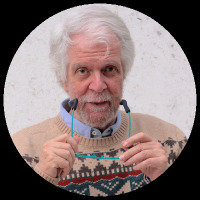
Jos Kleijne
My main interest is on the archaeology of prehistoric farming communities between the 4th and 2nd millennium BC. Particularly I'm working with settlement evidence, and the analysis of prehistoric material culture to study practices and to infer the mobility of new ideas, objects and people. Now learning about archaeological soil micromorphology and biogeochemistry to better understand subsistence practices and settlement activities.
From August 2018 onwards I'm working as a postdoc researcher at Kiel University within the SFB1266 programme. I'm working on Late Neolithic transformation processes in Northwest Europe.
Between November 2014 and July 2018 I was a PhD researcher at Kiel University (CAU). My thesis is published as 'Embracing Bell Beaker. Adopting new ideas and objects across Europe during the later 3rd millennium BC (c. 2600-2000 BC)' (Leiden: Sidestone Press, 2019).
Between September 2010 and September 2013 I worked at the Dutch Cultural Heritage Agency (Rijksdienst voor het Cultureel Erfgoed), as a researcher for later prehistoric (Late Neolithic - Iron Age) archaeology in the Netherlands. After this, I did research into the Bronze Age cultural landscape in the coastal dunes in North Holland, culminating in a book and several spin-off articles.
I did my BA and MA in archaeology at Leiden University. During my studies I participated in the Stonehenge Riverside Project excavations (2007 and 2008), I undertook an Erasmus-exchange to Sheffield (2008-2009) and I worked as a student assistant at DANS (Data Archiving for Dutch Archaeology, 2009-2010).
From August 2018 onwards I'm working as a postdoc researcher at Kiel University within the SFB1266 programme. I'm working on Late Neolithic transformation processes in Northwest Europe.
Between November 2014 and July 2018 I was a PhD researcher at Kiel University (CAU). My thesis is published as 'Embracing Bell Beaker. Adopting new ideas and objects across Europe during the later 3rd millennium BC (c. 2600-2000 BC)' (Leiden: Sidestone Press, 2019).
Between September 2010 and September 2013 I worked at the Dutch Cultural Heritage Agency (Rijksdienst voor het Cultureel Erfgoed), as a researcher for later prehistoric (Late Neolithic - Iron Age) archaeology in the Netherlands. After this, I did research into the Bronze Age cultural landscape in the coastal dunes in North Holland, culminating in a book and several spin-off articles.
I did my BA and MA in archaeology at Leiden University. During my studies I participated in the Stonehenge Riverside Project excavations (2007 and 2008), I undertook an Erasmus-exchange to Sheffield (2008-2009) and I worked as a student assistant at DANS (Data Archiving for Dutch Archaeology, 2009-2010).
less
Related Authors
John P Hart
New York State Museum
Dorian Q Fuller
University College London
Kim M Cohen
Utrecht University
Olivier LEMERCIER
Université Paul Valéry - Montpellier
Ladislav Šmejda
University of West Bohemia
Maurizio Forte
Duke University
Caroline J . Tully
University of Melbourne
Marta Diaz-Guardamino
Durham University
Armando Marques-Guedes
UNL - New University of Lisbon
Julian Thomas
The University of Manchester
InterestsView All (48)










Uploads
Papers and book chapters by Jos Kleijne
Dutch. This research project provided an excellent
opportunity to unlock the high quality archaeological information. The presence of organic remains and numerous artefacts in cultural layers and the thorough excavation of these layers have produced a wealth of data regarding Late Neolithic behavioural variability in a dynamic wetland landscape. In this article, a summary of the results of this project will be presented.
was carried out by several research institutes
and commercial companies in order to study
and publish three settlement sites of the Single
Grave Culture located in the Western Netherlands.
These sites were excavated more than
twenty years ago, but unfortunately the results
were only scarcely published, and mostly in
Dutch. This research project provided an excellent
opportunity to unlock the high quality
archaeological information. The presence of
organic remains and numerous artefacts in
cultural layers and the thorough excavation of
these layers have produced a wealth of data
regarding Late Neolithic behavioural variability
in a dynamic wetland landscape. In this
article, a summary of the results of this project
will be presented.
Article about primarily bone pendants dating between 3000 and 1800 BC in Western and Central Europe, found in graves associated with the Late Neolithic and Early Bronze Age. Their origin and development through time and space and possible use are outlined here. These small objects present a continuity in funerary traditions throughout the 3rd millennium BC (the Corded Ware, Bell Beaker phenomena).
but the fragments of four pots, its specific function is uncertain. The pottery itself can be characterized as fitting within the Northwest European Middle Bronze Age tradition, albeit that some particularities were food for further thoughts. One pot is archaeologically complete, bucket-shaped and decorated with two raised cordons with fingertip impressions. This kind of vessel is, with its specific form
and decoration, is uncommon in the Netherlands, yet has counterparts in Deverel Rimbury assemblages in Northern France and Britain. This important find, recovered from a natural-looking pit, implies that seemingly natural features merit more attention during archaeological fieldwork. Only then, more surprises like the pot from Tilburg-Stappegoor may come to light.
Kennemerland. Main focus was the analysis of the old excavations at Velserbroek,
which produced evidence for both farmyards and burial monuments. Finally, an
opportunity to study the unique relationship between Bronze Age burials and settlements
in this area presented itself. In this paper the characteristics of the various
burial monuments in the Velsen region are addressed.1
The barrows date from the
Bell Beaker Period onwards and present an extraordinary assemblage, with regard
to their spatial relationships, preservation and variety of burial types.
We can conclude that Zeewijk was a large domestic settlement, occupied all year round. In our view Zeewijk must be seen as a location where recurrent habitation took place, intensively, alternated with subsistence activities. It is a permanent mosaic of different assemblages: relocated dwellings, cultivated plots and the building and partial demolition of a remarkable ritual structure.
The habitants of Zeewijk carried out a broad spectrum of activities related to subsistence: mixed intensive farming (including small-scale crop cultivation, crop processing and
consumption, and animal herding and consumption), foraging, fishing, fowling and hunting all took place there. Furthermore there is ample evidence of craftsmanship.
This variety of local crafts, the construction and use of the large ceremonial building in Zeewijk-East and the large variation in ceramics are seen as indications that different groups of
Corded Ware people settled at Zeewijk. These groups were probably household groups, a community of several families, related by kinship both genetic and affinal.
Dutch. This research project provided an excellent
opportunity to unlock the high quality archaeological information. The presence of organic remains and numerous artefacts in cultural layers and the thorough excavation of these layers have produced a wealth of data regarding Late Neolithic behavioural variability in a dynamic wetland landscape. In this article, a summary of the results of this project will be presented.
was carried out by several research institutes
and commercial companies in order to study
and publish three settlement sites of the Single
Grave Culture located in the Western Netherlands.
These sites were excavated more than
twenty years ago, but unfortunately the results
were only scarcely published, and mostly in
Dutch. This research project provided an excellent
opportunity to unlock the high quality
archaeological information. The presence of
organic remains and numerous artefacts in
cultural layers and the thorough excavation of
these layers have produced a wealth of data
regarding Late Neolithic behavioural variability
in a dynamic wetland landscape. In this
article, a summary of the results of this project
will be presented.
Article about primarily bone pendants dating between 3000 and 1800 BC in Western and Central Europe, found in graves associated with the Late Neolithic and Early Bronze Age. Their origin and development through time and space and possible use are outlined here. These small objects present a continuity in funerary traditions throughout the 3rd millennium BC (the Corded Ware, Bell Beaker phenomena).
but the fragments of four pots, its specific function is uncertain. The pottery itself can be characterized as fitting within the Northwest European Middle Bronze Age tradition, albeit that some particularities were food for further thoughts. One pot is archaeologically complete, bucket-shaped and decorated with two raised cordons with fingertip impressions. This kind of vessel is, with its specific form
and decoration, is uncommon in the Netherlands, yet has counterparts in Deverel Rimbury assemblages in Northern France and Britain. This important find, recovered from a natural-looking pit, implies that seemingly natural features merit more attention during archaeological fieldwork. Only then, more surprises like the pot from Tilburg-Stappegoor may come to light.
Kennemerland. Main focus was the analysis of the old excavations at Velserbroek,
which produced evidence for both farmyards and burial monuments. Finally, an
opportunity to study the unique relationship between Bronze Age burials and settlements
in this area presented itself. In this paper the characteristics of the various
burial monuments in the Velsen region are addressed.1
The barrows date from the
Bell Beaker Period onwards and present an extraordinary assemblage, with regard
to their spatial relationships, preservation and variety of burial types.
We can conclude that Zeewijk was a large domestic settlement, occupied all year round. In our view Zeewijk must be seen as a location where recurrent habitation took place, intensively, alternated with subsistence activities. It is a permanent mosaic of different assemblages: relocated dwellings, cultivated plots and the building and partial demolition of a remarkable ritual structure.
The habitants of Zeewijk carried out a broad spectrum of activities related to subsistence: mixed intensive farming (including small-scale crop cultivation, crop processing and
consumption, and animal herding and consumption), foraging, fishing, fowling and hunting all took place there. Furthermore there is ample evidence of craftsmanship.
This variety of local crafts, the construction and use of the large ceremonial building in Zeewijk-East and the large variation in ceramics are seen as indications that different groups of
Corded Ware people settled at Zeewijk. These groups were probably household groups, a community of several families, related by kinship both genetic and affinal.
Instead, the author uses social theories on the spread of innovations, the development and functioning of communication networks and the social technologies involved in the production of material culture in his arguments. For the first time, settlements from various regions of Europe are studied at the same level and compared using modern research methods such as aoristic frequency distributions, the Bayesian modelling of radiocarbon dates and network analyses. Temporal and spatial variability in the regional processes that lead to the adoption (and rejection!) of Bell Beaker innovations are described in detail. The regional variability in communication between settlements, and the exchange of ideas and objects and mobility of people are combined with sociological network theories on the spread and adoption of novel ideas. Regional differences in the production of pottery are reviewed by both quantitative and qualitative methods.
Finally, a Bell Beaker network is described in which various processes of innovation adoption and subsequent re-invention, developing communication networks and different forms of mobility take part.
Research was funded by the Province of North-Holland and executed between February and November 2014.
The book itself can be bought at Huis van Hilde, the Archaeological Museum/Depot of the Province of North-Holland in Castricum (www.huisvanhilde.nl).
this volume the new results and interpretations are presented. The analyses show that Keinsmerbrug was a temporarily occupied settlement, used occasionally or perhaps even only
seasonally within the time span of 2580-2450 cal BC. The main period of use – probably consisting of several episodes of short-term use – occurred from spring to autumn. The site
of Keinsmerbrug is interpreted as a non-residential settlement: a gathering settlement in the broadest sense of the word, for the gathering of people and resources (special activity site).
This scientific report is intended for archaeologists, as well as for other professionals and amateur enthusiasts involved in archaeology.
The Cultural Heritage Agency provides knowledge and advice to give the future a past.
there is a more marked duality between the fragmented pattern of local styles and the new overarching transregional elements of material
culture, most notably expressed in archaeological terms by the Bell Beaker and Corded Ware phenomena. Such a duality, especially
marked by the concept of Bell Beakers and »Common Ware«, is surely not a total novelty. But the hitherto unknown width of distribution
of »global« Corded Ware, or Bell Beaker elements is evidence of a new character of this dialectic in the 3rd millennium BC.
In this workshop, we want to explore the background
of this new quality. To what extent is this re-arrangement of global and local frames of reference a consequence of a fundamental change in social organisation and economic practices? In how far does it reflect increased migration, new mobility patterns, or changing
networks of interaction? Or how can we disentangle the effect of different developments that might have lead to the culmination of the Neolithic sequence in European prehistory?
https://www.e-a-a.org/EAA2020
https://submissions.e-a-a.org/eaa2020/sessions/overview/preview.php?id=450
The ‘Beaker people’ have been part of our scientific discourse since the late 19th century. Subsequent generations have given different labels to the material patterns observed: culture, people, phenomenon.. This latter concept is nowadays also used for other labels: ‘Baden’, ‘Corded Ware’ or ‘Funnel Beaker’ (Furholt 2008, 2014), without necessarily changing anything in the methodology of prehistoric research. A similar development is now occurring with the maturing of aDNA studies (Olalde et al 2018; Eisenmann et al 2018). Do these different concepts represent prehistoric reality, or is a different methodology needed to understand “Similar but different” (Czebreszuk 2004) in cultural expressions across time and space?
One such methodology would be Social Network Analysis. Social Network Analysis originated in social sciences, coupled with mathematical concepts (graph theory, sociometry) and powered by computer tools since the 1970s (Granovetter 1973). From a theoretical point of view, it mobilizes relational information and studies interactions between different actors, in order to explain social facts (Collar et al 2015). From a practical point of view, it provides computer tools producing visualizations, mathematical indices (expressing the position of certain individuals (nodes) within a network), and understanding the spread of particular traits (e.g. Rogers 1979).
It was already Clarke (1976) who coined the term ‘Beaker network’. Recent work using this method for specifically the 3rd millennium BCE has increased dramatically (e.g. Furholt 2016; Kleijne 2019; Caraglio, Rios and Liesau, in press; Bourgeois/Kroon 2017). As this methodology is in development, many different perspectives exist on what can and should be done to answer to the problem of ‘Similar but Different’: How can we interpret the comparisons between "similarities networks"? Can they point out some "hubs" for the diffusion of material or immaterial representations? Are particular regions better or less integrated in networks?
This session invites papers that focus on various scales of analysis: From using networks to reconstruct human practices within specific contexts (such as 'Beaker' funerary deposits), and to understanding the large scale diffusion of Beaker ideas and the movement of people or material culture that characterise the 3rd millennium BC.
In 2021, we conducted an experiment into shell midden formation processes. We boiled and roasted shellfish, created a midden, and trampled specific parts of it. This report describes the choices we made in the process, the materials we used, the unexpected first results, and some further considerations. We will not delve deeper into the scientific nature of the endeavour, as the micromorphological work is still ongoing.
prehistory (2000-12 BCE; Bronze Age up to Late Iron Age) in the light of wider European trends, with special attention to the chronology, the (functional) ways in which glass is used in ornament traditions, the state and context of their deposition and (shifts in) composition and glass technology. First, a period-by-period overview of representative glass ornaments is offered for the temporal scope proposed, after which an integrated and diachronic synthesis of their composition is presented.
Present-day people from England and Wales harbour more ancestry derived from Early European Farmers (EEF) than people of the Early Bronze Age1. To understand this, we generated genome-wide data from 793 individuals, increasing data from the Middle to Late Bronze and Iron Age in Britain by 12-fold, and Western and Central Europe by 3.5-fold. Between 1000 and 875 BC, EEF ancestry increased in southern Britain (England and Wales) but not northern Britain (Scotland) due to incorporation of migrants who arrived at this time and over previous centuries, and who were genetically most similar to ancient individuals from France. These migrants contributed about half the ancestry of Iron Age people of England and Wales, thereby creating a plausible vector for the spread of early Celtic languages into Britain. These patterns are part of a broader trend of EEF ancestry becoming more similar across central and western Europe in the Middle to Late Bronze Age, coincident with archaeological evidence of intensified cultural exchange2–6. There was comparatively less gene flow from continental Europe during the Iron Age, and Britain’s independent genetic trajectory is also reflected in the rise of the allele conferring lactase persistence to ~50% by this time compared to ~7% in central Europe where it rose rapidly in frequency only a millennium later. This suggests that dairy products were used in qualitatively different ways in Britain and in central Europe over this period.